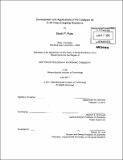| dc.contributor.advisor | Stephen L. Buchwald. | en_US |
| dc.contributor.author | Fors, Brett P | en_US |
| dc.contributor.other | Massachusetts Institute of Technology. Dept. of Chemistry. | en_US |
| dc.date.accessioned | 2011-08-18T19:10:47Z | |
| dc.date.available | 2011-08-18T19:10:47Z | |
| dc.date.copyright | 2011 | en_US |
| dc.date.issued | 2011 | en_US |
| dc.identifier.uri | http://hdl.handle.net/1721.1/65265 | |
| dc.description | Thesis (Ph. D.)--Massachusetts Institute of Technology, Dept. of Chemistry, 2011. | en_US |
| dc.description | Vita. Cataloged from PDF version of thesis. | en_US |
| dc.description | Includes bibliographical references. | en_US |
| dc.description.abstract | Chapter 1 A procedure for forming a highly active Pd(0) catalyst from Pd(OAc) 2, water, and biarylphosphine ligands has been developed. This protocol generates a catalyst system, which exhibits excellent reactivity and efficiency in the coupling of a variety of amides and anilines with aryl chlorides. Chapter 2 A new class of one-component Pd precatalysts bearing biarylphosphine ligands is described. These precatalysts are air- and thermally-stable, are easily-activated under normal reaction conditions at or below room temperature, and ensure the formation of the highly-active mono-ligated Pd(0) complex necessary for oxidative addition. The use of these precatalysts as a convenient source of LPd(0) in C-N cross-coupling reactions is explored. The reactivity that is demonstrated in this study is unprecedented in palladium chemistry. Chapter 3 A catalyst system based on a new biarylphosphine ligand that shows excellent reactivity for C-N cross-coupling reactions is reported. This catalyst system enables the use of aryl mesylates as a coupling partner in C-N bond-forming reactions. Additionally, the use of this ligand permits the highly selective monoarylation of an array of primary aliphatic amines and anilines at low catalyst loadings and with fast reaction times, including the first monoarylation of methylamine. Lastly, oxidative addition complexes based on the new ligand are included, which provide insight into the origin of reactivity for this system. Chapter 4 An investigation into the Pd-catalyzed C-N cross-coupling reactions of aryl iodides is described. Neal is shown to have a significant inhibitory effect on these processes. By switching to a solvent system in which the iodide byproduct was insoluble, reactions of aryl iodides were accomplished with the same efficiencies as aryl chlorides and bromides. Using catalyst systems based on certain biarylphosphine ligands, aryl iodides were successfully reacted with an array of primary and secondary amines in high yields. Lastly, reactions of heteroarylamines and heteroaryliodides were also conducted in high yields. Chapter 5 A catalyst based on a new biarylphosphine ligand for the Pd-catalyzed cross-coupling reactions of amides and aryl chlorides is described. This system shows the highest turnover frequencies reported to date for these reactions, especially for aryl chloride substrates bearing an ortho substituent. An array of amides and aryl chlorides were successfully reacted in good to excellent yields. Chapter 6. An efficient Pd-catalyst for the transformation of aryl chlorides, triflates and nonaflates to nitroaromatics has been developed. This reaction proceeds under weekly basic conditions and displays a broad scope and excellent functional group compatibility. Moreover, this method allows for the synthesis of aromatic nitro compounds that cannot be accessed efficiently via other nitration protocols. Mechanistic insight into the trasmetallation step of the catalytic process is also reported. Chapter 7. An alternative approach to catalyst development, which led to a Pd catalyst based on two biarylphosphine ligands for C-N cross-coupling reactions, is reported. By effectively being able to take the form of multiple catalysts this system manifests the best properties that catalysts based on either of the two ligands exhibit separately and displays the highest reactivity and substrate scope of any system that has been reported to date for these reactions. | en_US |
| dc.description.statementofresponsibility | by Brett P. Fors. | en_US |
| dc.format.extent | 605 p. | en_US |
| dc.language.iso | eng | en_US |
| dc.publisher | Massachusetts Institute of Technology | en_US |
| dc.rights | M.I.T. theses are protected by
copyright. They may be viewed from this source for any purpose, but
reproduction or distribution in any format is prohibited without written
permission. See provided URL for inquiries about permission. | en_US |
| dc.rights.uri | http://dspace.mit.edu/handle/1721.1/7582 | en_US |
| dc.subject | Chemistry. | en_US |
| dc.title | Development and Applications of Pd Catalysts for C-N Cross-Coupling Reactions | en_US |
| dc.type | Thesis | en_US |
| dc.description.degree | Ph.D. | en_US |
| dc.contributor.department | Massachusetts Institute of Technology. Department of Chemistry | |
| dc.identifier.oclc | 743718084 | en_US |
